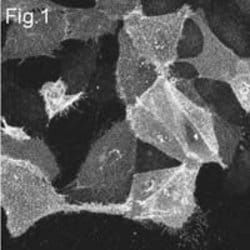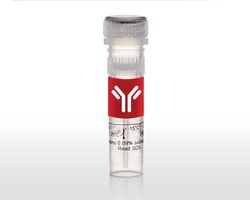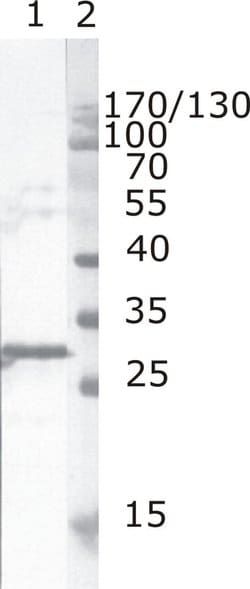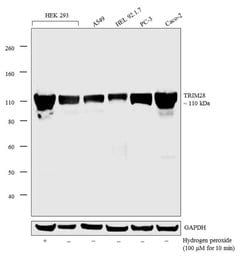MA12021
Acetylated Lysine Monoclonal Antibody (1C6), Invitrogen™
Manufacturer: Thermo Scientific
Select a Size
| Pack Size | SKU | Availability | Price |
|---|---|---|---|
| Each of 1 | MA12021-Each-of-1 | In Stock | ₹ 50,018.00 |
MA12021 - Each of 1
In Stock
Quantity
1
Base Price: ₹ 50,018.00
GST (18%): ₹ 9,003.24
Total Price: ₹ 59,021.24
Antigen
Acetylated Lysine
Classification
Monoclonal
Concentration
1 mg/mL
Formulation
PBS with 1mg/mL BSA and 0.05% sodium azide
Host Species
Mouse
Purification Method
Protein G
Regulatory Status
RUO
Target Species
Chemical
Product Type
Antibody
Isotype
IgG2b
Applications
ChIP Assay, Dot Blot, Immunocytochemistry, Immunoprecipitation, Peptide Array, Western Blot
Clone
1C6
Conjugate
Unconjugated
Gene Alias
Acetyl Lysine; Acetylated Lysine; Acetyllysine
Immunogen
Synthetic peptide sequence surrounding the acetylated lysine 9 of histone H3.
Quantity
100 μg
Primary or Secondary
Primary
Content And Storage
-20° C, Avoid Freeze/Thaw Cycles
Form
Liquid
Target Molecule
Chemical
Related Products
Description
- MA1-2021 detects human and mouse, and monkey acetylated lysine
- MA1-2021 has been used successfully in Western blot, immunoprecipitation, dot blot, ChIP Assay, and immunofluorescence (cells) procedures
- By Western blot, this antibody may detect a ladder of acetylated proteins in HeLa cell lysate
- In immunofluorescence procedures, MA1-2021 recognizes acetylated lysine in gamma irradiated HeLa cells
- The MA1-2021 immunogen is a synthetic peptide sequence surrounding the acetylated lysine 9 of histone H3
- In the nucleus, DNA is tightly packed into nucleosomes generating an environment which is highly repressive towards DNA processes such as transcription
- Acetylation of lysine residues within proteins has emerged as an important mechanism used by cells to overcome this repression
- The acetylation of non-histone proteins such as transcription factors, as well as histones appears to be involved in this process
- Acetylation may result in structural transitions as well as specific signaling within discrete chromatin domains
- The role of acetylation in intracellular signaling has been inferred from the binding of acetylated peptides by the conserved bromodomain
- Furthermore, recent findings suggest that bromodomain/acetylated-lysine recognition can serve as a regulatory mechanism in protein-protein interactions in numerous cellular processes such as chromatin remodeling and transcriptional activation.
Compare Similar Items
Show Difference
Antigen: Acetylated Lysine
Classification: Monoclonal
Concentration: 1 mg/mL
Formulation: PBS with 1mg/mL BSA and 0.05% sodium azide
Host Species: Mouse
Purification Method: Protein G
Regulatory Status: RUO
Target Species: Chemical
Product Type: Antibody
Isotype: IgG2b
Applications: ChIP Assay, Dot Blot, Immunocytochemistry, Immunoprecipitation, Peptide Array, Western Blot
Clone: 1C6
Conjugate: Unconjugated
Gene Alias: Acetyl Lysine; Acetylated Lysine; Acetyllysine
Immunogen: Synthetic peptide sequence surrounding the acetylated lysine 9 of histone H3.
Quantity: 100 μg
Primary or Secondary: Primary
Content And Storage: -20° C, Avoid Freeze/Thaw Cycles
Form: Liquid
Target Molecule: Chemical
Antigen:
Acetylated Lysine
Classification:
Monoclonal
Concentration:
1 mg/mL
Formulation:
PBS with 1mg/mL BSA and 0.05% sodium azide
Host Species:
Mouse
Purification Method:
Protein G
Regulatory Status:
RUO
Target Species:
Chemical
Product Type:
Antibody
Isotype:
IgG2b
Applications:
ChIP Assay, Dot Blot, Immunocytochemistry, Immunoprecipitation, Peptide Array, Western Blot
Clone:
1C6
Conjugate:
Unconjugated
Gene Alias:
Acetyl Lysine; Acetylated Lysine; Acetyllysine
Immunogen:
Synthetic peptide sequence surrounding the acetylated lysine 9 of histone H3.
Quantity:
100 μg
Primary or Secondary:
Primary
Content And Storage:
-20° C, Avoid Freeze/Thaw Cycles
Form:
Liquid
Target Molecule:
Chemical
Antigen: Phospho-Histone H2A.X (Ser139)
Classification: Monoclonal
Concentration: 1 mg/mL
Formulation: PBS with 1mg/mL BSA and 0.05% sodium azide
Host Species: Mouse
Purification Method: Protein G
Regulatory Status: RUO
Target Species: Human, Mouse
Product Type: Antibody
Isotype: IgG1 κ
Applications: ELISA, Flow Cytometry, Immunocytochemistry, Immunohistochemistry (Paraffin), Western Blot
Clone: 3F2
Conjugate: Unconjugated
Gene Alias: AW228881; gamma H2AX; gammaH2ax; H2A histone family member X; H2A histone family, member X; H2A.X; H2A.X variant histone; H2A/X; h2afx; H2ax; H2AX histone; Hist5-2ax; histone 5 protein 2ax; histone H2A.x; Histone H2a/x; Histone H2AX; RGD1566119; similar to H2A histone family, member X; zgc:56329
Immunogen: Synthetic peptide sequence surrounding phosphorylated Ser140
Quantity: 100 μg
Primary or Secondary: Primary
Content And Storage: -20° C, Avoid Freeze/Thaw Cycles
Form: Liquid
Target Molecule: __
Antigen:
Phospho-Histone H2A.X (Ser139)
Classification:
Monoclonal
Concentration:
1 mg/mL
Formulation:
PBS with 1mg/mL BSA and 0.05% sodium azide
Host Species:
Mouse
Purification Method:
Protein G
Regulatory Status:
RUO
Target Species:
Human, Mouse
Product Type:
Antibody
Isotype:
IgG1 κ
Applications:
ELISA, Flow Cytometry, Immunocytochemistry, Immunohistochemistry (Paraffin), Western Blot
Clone:
3F2
Conjugate:
Unconjugated
Gene Alias:
AW228881; gamma H2AX; gammaH2ax; H2A histone family member X; H2A histone family, member X; H2A.X; H2A.X variant histone; H2A/X; h2afx; H2ax; H2AX histone; Hist5-2ax; histone 5 protein 2ax; histone H2A.x; Histone H2a/x; Histone H2AX; RGD1566119; similar to H2A histone family, member X; zgc:56329
Immunogen:
Synthetic peptide sequence surrounding phosphorylated Ser140
Quantity:
100 μg
Primary or Secondary:
Primary
Content And Storage:
-20° C, Avoid Freeze/Thaw Cycles
Form:
Liquid
Target Molecule:
__
Antigen: TRIM28
Classification: Monoclonal
Concentration: 1 mg/mL
Formulation: PBS with 1mg/mL BSA and 0.05% sodium azide
Host Species: Mouse
Purification Method: Protein G
Regulatory Status: RUO
Target Species: Human, Mouse
Product Type: Antibody
Isotype: IgG1
Applications: ChIP Assay, Gel Shift, Immunocytochemistry, Immunoprecipitation, Western Blot
Clone: 20C1
Conjugate: Unconjugated
Gene Alias: AA408787; E3 SUMO-protein ligase TRIM28; KAP1; KAP-1; KRAB [Kruppel-associated box domain]-associated protein 1; KRAB-A-interacting protein; KRAB-associated protein 1; KRAB-interacting p; KRAB-interacting protein 1; Krip1; KRIP-1; MommeD9; Nuclear corepressor KAP-1; PPP1R157; protein phosphatase 1, regulatory subunit 157; RING finger protein 96; RING-type E3 ubiquitin transferase TIF1-beta; RNF96; TF1B; tif1 beta; Tif1b; Tif1beta; TIF1-beta; Transcription intermediary factor 1-beta; transcriptional intermediary factor 1, beta; transcriptional intermediary factor 1-beta; Trim28; tripartite motif; tripartite motif containing 28; tripartite motif protein 28; tripartite motif-containing 28; tripartite motif-containing protein 28
Immunogen: Recombinant protein corresponding to residues 60-383 of the human TIF1 beta protein.
Quantity: 100 μg
Primary or Secondary: Primary
Content And Storage: -20° C, Avoid Freeze/Thaw Cycles
Form: Liquid
Target Molecule: __
Antigen:
TRIM28
Classification:
Monoclonal
Concentration:
1 mg/mL
Formulation:
PBS with 1mg/mL BSA and 0.05% sodium azide
Host Species:
Mouse
Purification Method:
Protein G
Regulatory Status:
RUO
Target Species:
Human, Mouse
Product Type:
Antibody
Isotype:
IgG1
Applications:
ChIP Assay, Gel Shift, Immunocytochemistry, Immunoprecipitation, Western Blot
Clone:
20C1
Conjugate:
Unconjugated
Gene Alias:
AA408787; E3 SUMO-protein ligase TRIM28; KAP1; KAP-1; KRAB [Kruppel-associated box domain]-associated protein 1; KRAB-A-interacting protein; KRAB-associated protein 1; KRAB-interacting p; KRAB-interacting protein 1; Krip1; KRIP-1; MommeD9; Nuclear corepressor KAP-1; PPP1R157; protein phosphatase 1, regulatory subunit 157; RING finger protein 96; RING-type E3 ubiquitin transferase TIF1-beta; RNF96; TF1B; tif1 beta; Tif1b; Tif1beta; TIF1-beta; Transcription intermediary factor 1-beta; transcriptional intermediary factor 1, beta; transcriptional intermediary factor 1-beta; Trim28; tripartite motif; tripartite motif containing 28; tripartite motif protein 28; tripartite motif-containing 28; tripartite motif-containing protein 28
Immunogen:
Recombinant protein corresponding to residues 60-383 of the human TIF1 beta protein.
Quantity:
100 μg
Primary or Secondary:
Primary
Content And Storage:
-20° C, Avoid Freeze/Thaw Cycles
Form:
Liquid
Target Molecule:
__
Antigen: Placental Alkaline Phosphatase
Classification: Monoclonal
Concentration: 1 mg/mL
Formulation: PBS with 0.09% sodium azide
Host Species: Mouse
Purification Method: Protein G
Regulatory Status: RUO
Target Species: Human
Product Type: Antibody
Isotype: IgG1
Applications: ELISA, Flow Cytometry, Immunohistochemistry (Frozen)
Clone: H17E2
Conjugate: Unconjugated
Gene Alias: Alkaline phosphatase placental type; Alkaline phosphatase Regan isozyme; alkaline phosphatase, placental; alkaline phosphatase, placental type; alkaline phosphomonoesterase; ALP; Alp1; ALPP; AP-TNAP; DOA1; FLJ11281; FLJ40094; FLJ61142; FLJ93059; Germ-cell alkaline phosphatase; glycerophosphatase; HOPS; MGC161443; MGC167935; nagao Isozyme; P PLAP; PALP; PLA2P; PLAA; placental alkaline phosphatase 1; placental heat-stable alkaline phosphatase; PLAP; PLAP1; PLAP-1; rCG23846-like; Regan isozyme; TNAP; TNSALP
Immunogen: Human placental membrane.
Quantity: 100 μg
Primary or Secondary: Primary
Content And Storage: Store at 4°C short term. For long term storage, store at -20°C, avoiding freeze/thaw cycles.
Form: Liquid
Target Molecule: __
Antigen:
Placental Alkaline Phosphatase
Classification:
Monoclonal
Concentration:
1 mg/mL
Formulation:
PBS with 0.09% sodium azide
Host Species:
Mouse
Purification Method:
Protein G
Regulatory Status:
RUO
Target Species:
Human
Product Type:
Antibody
Isotype:
IgG1
Applications:
ELISA, Flow Cytometry, Immunohistochemistry (Frozen)
Clone:
H17E2
Conjugate:
Unconjugated
Gene Alias:
Alkaline phosphatase placental type; Alkaline phosphatase Regan isozyme; alkaline phosphatase, placental; alkaline phosphatase, placental type; alkaline phosphomonoesterase; ALP; Alp1; ALPP; AP-TNAP; DOA1; FLJ11281; FLJ40094; FLJ61142; FLJ93059; Germ-cell alkaline phosphatase; glycerophosphatase; HOPS; MGC161443; MGC167935; nagao Isozyme; P PLAP; PALP; PLA2P; PLAA; placental alkaline phosphatase 1; placental heat-stable alkaline phosphatase; PLAP; PLAP1; PLAP-1; rCG23846-like; Regan isozyme; TNAP; TNSALP
Immunogen:
Human placental membrane.
Quantity:
100 μg
Primary or Secondary:
Primary
Content And Storage:
Store at 4°C short term. For long term storage, store at -20°C, avoiding freeze/thaw cycles.
Form:
Liquid
Target Molecule:
__








